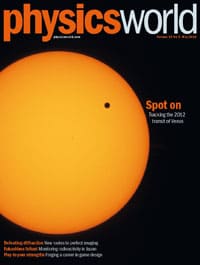By Matin Durrani

When it comes to scientific events that can get the whole world thrilled – researchers and non-scientists alike – astronomy wins hands down. Eclipses, comets or meteor showers, for example, are rare enough to get anyone with even a passing interest in science excited. But for true once-in-a-lifetime astronomical events, nothing can beat next month’s transit of Venus, in which our sister planet passes across the face of the Sun as viewed from Earth.
Transits of Venus occur in pairs eight years apart, with each pair separated by gaps of more than a century. The last transit occurred in 2004, meaning that the upcoming transit on 5–6 June will almost certainly be your only chance to see this rare astronomical alignment, as it will not occur again until 2117. For more on the science and history of this astronomical spectacular, don’t miss the fantastic feature “Venus: it’s now or never” by one of the world’s leading transit experts, Jay Pasachoff.
You can read the article here but to enjoy the article and images in all their glory, check out the May 2012 issue of Physics World. Members of the Institute of Physics (IOP) can read the new issue online for free right now through the digital version of the magazine by following this link or by downloading the Physics World app onto your iPhone or iPad or Android device, both available from the App Store and Google Play, respectively. The digital version lets you read, share, save, archive and print articles – either fully laid out or in plain-text view – and even have them translated or read out to you.
If you’re not yet a member, you can join the IOP as an imember for just £15, €20 or $25 a year via this link Being an imember gives you a full year’s access to Physics World both online and through the apps. To whet your appetite still further, here’s a quick summary of what else is in the new issue. And remember, let me know what you think of any of the topics by e-mailing me at pwld@iop.org.
• Atmospheric tales – Robert P Crease reveals why the discovery of Venus’s atmosphere is still so controversial.
• Quantum technologies: an old new story – Technologies based on the
properties of quantum mechanics have been around for many years, but Iulia Georgescu
and Franco Nori argue that we need a new definition for “quantum technologies”.
• Japan’s X-ray vision for the future – With the world’s first “compact” X-ray free-electron laser having opened its doors to users in March, Michael Banks travels to the remote SACLA facility in the mountains of western Japan to find out more about this ambitious new project.
• Fukushima fallout – Steven Judge and Hiroyuki Kuwahara report on efforts to monitor radioactive contamination in areas near the stricken Fukushima Daiichi reactor.
• Defeating diffraction – Once thought to offer imaging at unlimited resolution beyond that permitted by diffraction, superlenses never quite worked in practice. Now, physicists have a host of other ideas to make perfect images, but can these concepts succeed where superlenses failed? Jon Cartwright reports.
• Playing the game – Catherine Goode describes how a degree in physics and a childhood passion for computer and video games led her to a career in game design.
• Towards a Standard Model of finance – Andrew Aus looks at links between physics and finance in this month’s Lateral Thoughts column.



